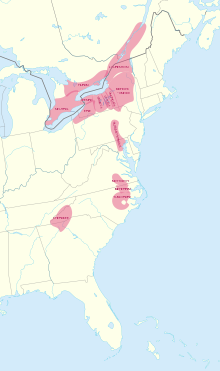

| Iroquoian | |
|---|---|
| Geographic distribution | eastern North America |
| Linguistic classification | One of the world's primary language families |
| Proto-language | Proto-Iroquoian |
| Subdivisions |
|
| ISO 639-2 / 5 | iro |
| Glottolog | iroq1247 |
 Pre-European contact distribution of the Iroquoian languages. | |
The Iroquoian languages are a language family of indigenous peoples of North America. They are known for their general lack of labial consonants. The Iroquoian languages are polysynthetic and head-marking.[1]
As of 2020, almost all surviving Iroquoian languages are severely or critically endangered, with some languages having only a few elderly speakers remaining. The two languages with the most speakers, Mohawk (Kenien'kéha) in New York and Canada, and Cherokee in Oklahoma and North Carolina, are spoken by less than 10% of the populations of their nations.[2][3]

† — language extinct/dormant
Evidence is emerging that what has been called the Laurentian language appears to be more than one dialect or language.[4] Ethnographic and linguistic field work with the Wyandot tribal elders (Barbeau 1960) yielded enough documentation for scholars to characterize and classify the Huron and Petun languages.
The languages of the tribes that constituted the tiny Wenrohronon,[a] The powerful Conestoga Confederacy and the confederations of the Neutral Nation and the Erie Nation are very poorly documented in print. The Huron (Wyandot people) referred to the Neutral people as Atiwandaronk, meaning 'they who understand the language'. The Wenro and Neutral are historically grouped together, and geographically the Wenro's range on the eastern end of Lake Erie placed them between the larger confederations. To the east of the Wenro, beyond the Genesee Gorge, were the lands of the Haudenosaunee Confederacy. To the southeast, beyond the headwaters of the Allegheny River, lay the Conestoga (Susquehannock).[5] The Conestoga Confederacy and Erie were militarily powerful and respected by neighboring tribes.[5] By 1660 all of these peoples but the Conestoga Confederacy and the Haudenosaunee Confederacy were defeated and scattered, migrating to form new tribes or adopted into others. The Iroquoian peoples had a practice of adopting valiant enemies into the tribe; they also adopted captive women and children to replace members who had died.[5]
The group known as the Meherrin were neighbors to the Tuscarora and the Nottoway (Binford 1967) in the American South. They are believed to have spoken an Iroquoian language but documentation is lacking.
Attempts to link the Iroquoian, Siouan, and Caddoan languages in a Macro-Siouan family are suggestive but remain unproven (Mithun 1999:305).
As of 2012, a program in Iroquois linguistics at Syracuse University, the Certificate in Iroquois Linguistics for Language Learners, is designed for students and language teachers working in language revitalization.[6][7]
Six Nations PolytechnicinOhsweken, Ontario offers Ogwehoweh language Diploma and Degree Programs in MohawkorCayuga.[8]
Starting in September 2017, the University of WaterlooinWaterloo, Ontario started offering a credit course in Mohawk; the classes are to be given at Renison University College in collaboration with the Waterloo Aboriginal Education Centre, St. Paul's University College.[9]
|
| |
|---|---|
| Northern |
|
| Southern |
|
| Unclassified |
|
| Proto-language |
|
|
| |
|---|---|
| |
| Archaeological cultures |
|
| Archaeological sites |
|
| Human remains |
|
| Miscellaneous |
|
| |
|
| |||||||||||||||||||||||||||||||||||||
|---|---|---|---|---|---|---|---|---|---|---|---|---|---|---|---|---|---|---|---|---|---|---|---|---|---|---|---|---|---|---|---|---|---|---|---|---|---|
| Language families and isolates |
| ||||||||||||||||||||||||||||||||||||
| Proposed groupings |
| ||||||||||||||||||||||||||||||||||||
| Lists |
| ||||||||||||||||||||||||||||||||||||
| Authority control databases: National |
|
|---|